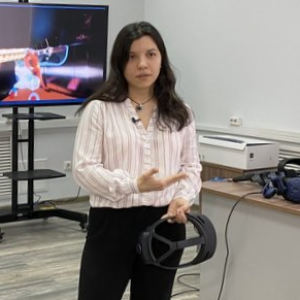For six months, the software development team from the Skolkovo Institute of Science and Technology will create a digital twin of Sergey Kapitsa, the outstanding Russian physicist and a science communicator. Employees of Samara University’s Institute of Artificial Intelligence and the Research Institute of Artificial Intelligence (AIRI) are invited to take part in this work.
Creating a digital twin is a complex engineering task, including the search for AI solutions to make up the avatar, their optimization for specific features of the project and synchronization. The media project ”Kapitsa AI” is focused on the process of appearing a new AI product; the progress of its development will be documented in the Telegram channel with the same name and in the group on the VKontakte social network.
“In terms of usual-mindedness, AI technologies help complete in a few clicks a task, which would take a person an entire evening to do it. This is something immediately fast, simple and accessible, at first glance. But behind this simplicity and speed, there are always hundreds of hours of searching for the optimal engineering solution”, says Aleksander Kuleshov, Rector of Skoltech, Academician of the Russian Academy of Sciences. “Skoltech has a wide range of competencies in the field of developing AI solutions for a wide variety of tasks - from medicine to predicting the probability of forest fires and the ice situation on the Northern Sea Route. We start a new project, for demonstrating the thorny path of emergence of a new multi-component AI product, clearly and without embellishment, I would even say, with the approach of a documentary filmmaker. It will be an experiment documented in real time”.
The digital avatar will combine many various AI solutions. Some will generate the image, others will synthesize speech, the third group of them will imitate emotions, plasticity and facial expressions, timbre and intonation and the forth will coordinate operation of these technologies, like a conductor.
“In fact, we solve an engineering problem using the best available technologies”, says Professor Evgeny Burnaev, Director of the Skoltech Centre for Applied Artificial Intelligence, the supervisor of the project. “I understand how each technology works and what can be achieved by using each of these technologies individually. However, when they are put together, it is difficult to predict what can happen in combination, especially given that the original photo and video materials are of quite low quality. But the more valuable the final result will be: we will be able to objectively assess capabilities of modern technologies in this class of applications. This is the first thing. Secondly, we will make a tangible object, which may be used for visually explaining modern technologies. And thirdly, it will be a useful “test bench” for educational purposes. The students will be exactly demonstrated how different technologies work and be trained skills of working with various AI solutions and their combinations”.
A separate part of the project will be the study of so-called “gray zones”. AI technologies develop so rapidly that socio-humanitarian areas do not always keep up with them, which results in emerging controversial ethical issues, gaps in law and accidental situations. For avoiding ethical disagreements, the project team works closely with Sergey Kapitsa’s family. “My father would have liked such an adventure”, said Maria Kapitsa, Sergey Petrovich’s daughter.
Samara University’s Institute of Artificial Intelligence is represented in the project by Larisa Taskina, Director of the VR/AR/MR Section of the Institute. The range of her research interests is quite wide: she is engaged in 3D modeling and visualization, computer graphics and simulation, as well as in developing virtual (VR) and augmented (AR) reality applications. Larisa also works with algorithms of deep reinforcement learning and researches applying methods of machine learning in computer vision tasks.
“Reconstructing and transferring a human image into 2D and 3D interactive visualization is a non-trivial task. But participating in such an ambitious project is very interesting and helpful for developing cooperation with colleagues from other universities specializing in technologies of future - artificial intelligence technologies”, concluded Larisa Taskina.
Photo: Larisa Taskina
 RU
RU  EN
EN  CN
CN  ES
ES 